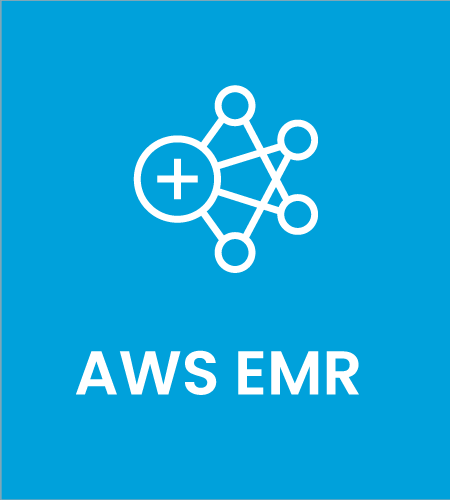Which Platform is Right for You?
AWS is the largest public and private cloud data center provider in the world. As part of its big data processing portfolio, AWS has developed Glue and Amazon EMR. AWS Glue is an extract, transform, load (ETL) tool that helps data scientists to manipulate and move data via Amazon S3.
Amazon EMR, short for Amazon Elastic MapReduce, is a big data processing, real-time data streams, SQL querying, and machine learning platform. EMR can be used to execute and scale up Apache Spark clusters, among other big data engines.
While both tools provide ETL processing capabilities, which one you choose will be highly dependent on your current infrastructure. Let us explore AWS Glue vs. EMR so you can decide if using both platforms in parallel or choosing one is right for your business.

What is AWS Glue?
<a href="https://aws.amazon.com/glue" target="_blank">AWS Glue</a> is a serverless data integration service available on the AWS cloud. The platform aims to help data analysts discover data across diverse sources, prepare the data into multiple formats and schemas, and combine datasets using data mapping. AWS Glue works with a range of data stores like databases, data lakes, and data warehouse sources.
The barrier of entry to ETL workflows is lowered thanks to visualized interfaces for non-technical users, alongside more powerful code-based interfaces for technical users. All metadata for AWS Glue is stored in the AWS Glue Data Catalog, meaning any user can find and access relevant datasets.

What is Amazon EMR?
Amazon Elastic MapReduce (EMR) is a big data platform. It supports real-time data streaming for artificial intelligence and machine learning workloads via Apache Spark and other analytics engines. This is enabled by scalable data pipelines that extract data from the source and deliver it to the target. Large-scale predictive analytics and statistical models in EMR can also be used to help uncover trends and correlations.
The benefits of EMR include petabyte-level scalability at half the cost of on-premises, and up to two times faster time-to-insight for analytics workloads. The EMR Studio can be used to build data pipelines, visualize data flow, and execute SQL queries.
Types of Data Monetization
There are several methods for monetizing data, but the one organizations choose should give the agility and flexibility to extract the most value from big data sources. To help you decide which method works best with your data strategy, here are the four most popular data monetization strategies:
Serverless vs. Managed Services
AWS Glue is a serverless data integration platform that handles the infrastructure, configuration options, and setup. It can work with structured and semi-structured data formats to automatically infer schema references.
Amazon EMR is a managed service overlay for self-configured infrastructures, such as Amazon EC2 instances or clusters. EMR does also offer a dedicated serverless option. EMR supports Apache Hadoop ecosystem components like Spark, Hive, HBase and Presto, with data storage in Amazon Athena, Amazon Redshift, and other big data analytics solutions.
In summary, AWS Glue is a scalable ETL platform that is easy to set up and use. However, its ease of use comes with limitations, making it better suited to jobs with more flexible infrastructure requirements. Amazon EMR has a much richer feature set, including Hadoop component hosting compatibility, TensorFlow machine learning libraries, and Presto SQL queries. Glue is suited to simpler data ETL and integration workflows, whereas EMR is a more comprehensive data operations managed service platform.
Expenses, Operating Costs, and Pricing
As with most cloud services, the more it does for you out of the box, the more expensive it will be. AWS Glue is a serverless platform, meaning you can ignore infrastructure deployment and configuration to focus on ETL workflows.
EMR taps into existing data sources to facilitate SQL querying, data streaming, and other ETL processes. This results in lower costs, as the data deployment and configuration burden are yours. These lower costs may be offset by paying employees to configure and deploy EMR, and the added operating expense for each accompanying AWS service.
You can compare the cost of each service for your intended use case with the AWS Pricing Calculator..
Performance Limitations
As of April 2022, AWS Glue’s largest worker type is G.2X. This comes with an upper limit of 32GB of executor memory, meaning unzipping highly compressed files can lead to “out of memory” errors. Whereas EMR can use any AWS instance type, allowing for much larger RAM allocations up to 24 Tebibytes (TiB).
Use Cases and Scenarios for AWS Glue and EMR
For those storing data at a massive scale in the cloud, it is beneficial to use distributed computing engines, cloud-native databases, and data warehouses. Amazon EMR and AWS Glue are two services organizations can use to accomplish this. Let’s explore two more scenarios where Glue jobs or EMR may be more suited to using separate.
New Data Workflow, Testing Environment, or Sandbox
If you are testing a brand-new data workflow, AWS Glue may be a better option. It allows you to skip configuration and deployment of infrastructure, and simply execute a data workflow. The pay-as-you-go (PAYG) nature of Glue leads to little risk of wasted spending.
Configuring an EMR cluster for testing environments and one-off workflows would increase effort with little benefit to the business. The only issue would be Glue compatibility with the data source. In contrast, EMR offers more flexibility using all AWS instance types.
Big Data Processing and Machine Learning
For big data processing or machine learning workloads, EMR may be a better option due to its flexibility. It can securely and reliably handle machine learning, deep learning, data ETL, and real-time streaming analytics.
Glue is more focused on extract, transform and load (ETL) actions. It can execute machine learning transforms but has many limitations for real-time streaming analytics due to processing and writing windows that last 100 seconds. Glue Schema detection also disables streaming data join actions, with only built-in Glue transforms or Apache Spark Structured Streaming transforms being supported.
AWS Glue vs. EMR Summary
AWS Glue and Amazon EMR are similar platforms differentiated by their simplicity and flexibility. AWS Glue is a quick, low-effort way to execute ETL jobs in the cloud. EMR is a more robust, feature-rich big data processing solution that enables ETL alongside real-time data streaming for ML workloads using existing infrastructure. EMR’s flexibility comes with a management burden, but often results in less expense than Glue, thanks to avoiding serverless features.
Ultimately, Amazon EMR is suited to small-scale and large-scale data operations, whereas Glue is much more ad-hoc and suited to small batch jobs. However, since they serve different purposes, you may find yourself using both tools — Glue for ad-hoc tasks that you want to stand up quickly and EMR for long-term, large-scale distributed data processing jobs.
Want to learn more about ETL migration?
Find out how Trianz decreases migration times from legacy databases and existing ETL tools to AWS Glue by up to 50%.
Learn More About AWS GlueExperience the Trianz Difference
Trianz enables digital transformations through effective strategies and excellence in execution. Collaborating with business and technology leaders, we help formulate and execute operational strategies to achieve intended business outcomes by bringing the best of consulting, technology experiences and execution models.
Powered by knowledge, research, and perspectives, we enable clients to transform their business ecosystems and achieve superior performance by leveraging infrastructure, cloud, analytics, digital, and security paradigms. Reach out to get in touch or learn more.

